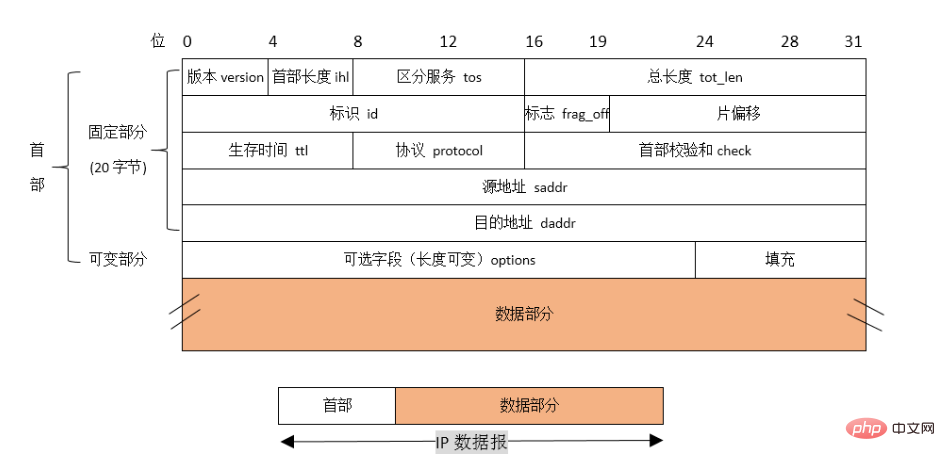What is iphdr in linux
In Linux, iphdr is the description structure of the ip data packet; the header file where iphdr is located is "/usr/src/linux/include/linux/ip.h", and the structure is composed of a batch of data The combined structured data. Each data that makes up the structured data is called a member of the structured data, which describes the size and interpretation meaning of a memory interval.

#The operating environment of this tutorial: linux7.3 system, Dell G3 computer.
What is iphdr in Linux
iphdr is a computer term. It is the description structure of IP data packet under Linux.
The header file is /usr/src/linux/include/linux/ip.h, the structure is as follows:
struct iphdr {
#if defined(__LITTLE_ENDIAN_BITFIELD) //小端模式下
__u8 ihl:4,//首部长度(4位)
version:4;//ip协议版本IPv4
#elif defined (__BIG_ENDIAN_BITFIELD) //大端模式下
__u8 version:4,
ihl:4;
#else
#error "Please fix <asm/byteorder.h>"
#endif
__u8 tos;//服务类型字段(8位)
__be16 tot_len;//16位IP数据报总长度
__be16 id;//16位标识字段(唯一表示主机发送的每一分数据报)
__be16 frag_off;//(3位分段标志+13位分段偏移数)
__u8 ttl;//8位数据报生存时间
__u8 protocol;//协议字段(8位)
__be16 check;//16位首部校验
__be32 saddr; //源IP地址
__be32 daddr; //目的IP地址
};
Extended knowledge
iphdr->version
Version (4 digits), the current protocol version number is 4, so IP is sometimes called IPv4.
iphdr->ihl
Header length (4 bits): The header length refers to the number of 32-bit words in the IP layer header (that is, how many 4 bits the IP layer header contains Bytes – 32 bits), including any options. Since it is a 4-bit field, the header can be up to 60 bytes long. The value of the ordinary IP datagram (without any options) field is 5 5 * 32 / 8 = 5 * 4 = 20 Bytes.
iphdr->tos
Service type field (8 bits): The service type (TOS) field includes a 3-bit priority subfield (now ignored), 4-bit TOS subfield and 1 bit are unused but must be set to 0. The 4-bit TOS subfield represents: minimum delay, maximum throughput, maximum reliability and minimum cost respectively. Only 1 bit among the 4 bits can be set. If all 4 bits are 0, it means normal service.
iphdr->tot_len
The total length field (16 bits) refers to the length of the entire IP datagram, in bytes. Using the header length field and total length field, you can know the starting position and length of the data content in the IP datagram. Since this field is 16 bits long, the IP datagram can be up to 65535 bytes long. The total length field is a necessary content in the IP header because some data links (such as Ethernet) need to fill in some data to reach the minimum length. Although the minimum frame length of Ethernet is 46 bytes, IP data may be shorter. If there is no total length field, then the IP layer does not know how much of the 46 bytes is the content of the IP datagram.
iphdr->id
The identification field (16 bits) uniquely identifies each datagram sent by the host. Usually its value is incremented by 1 every time a message is sent.
Recommended learning: Linux video tutorial
The above is the detailed content of What is iphdr in linux. For more information, please follow other related articles on the PHP Chinese website!

Hot AI Tools

Undresser.AI Undress
AI-powered app for creating realistic nude photos

AI Clothes Remover
Online AI tool for removing clothes from photos.

Undress AI Tool
Undress images for free

Clothoff.io
AI clothes remover

Video Face Swap
Swap faces in any video effortlessly with our completely free AI face swap tool!

Hot Article

Hot Tools

Notepad++7.3.1
Easy-to-use and free code editor

SublimeText3 Chinese version
Chinese version, very easy to use

Zend Studio 13.0.1
Powerful PHP integrated development environment

Dreamweaver CS6
Visual web development tools

SublimeText3 Mac version
God-level code editing software (SublimeText3)

Hot Topics
 What computer configuration is required for vscode
Apr 15, 2025 pm 09:48 PM
What computer configuration is required for vscode
Apr 15, 2025 pm 09:48 PM
VS Code system requirements: Operating system: Windows 10 and above, macOS 10.12 and above, Linux distribution processor: minimum 1.6 GHz, recommended 2.0 GHz and above memory: minimum 512 MB, recommended 4 GB and above storage space: minimum 250 MB, recommended 1 GB and above other requirements: stable network connection, Xorg/Wayland (Linux)
 Linux Architecture: Unveiling the 5 Basic Components
Apr 20, 2025 am 12:04 AM
Linux Architecture: Unveiling the 5 Basic Components
Apr 20, 2025 am 12:04 AM
The five basic components of the Linux system are: 1. Kernel, 2. System library, 3. System utilities, 4. Graphical user interface, 5. Applications. The kernel manages hardware resources, the system library provides precompiled functions, system utilities are used for system management, the GUI provides visual interaction, and applications use these components to implement functions.
 vscode terminal usage tutorial
Apr 15, 2025 pm 10:09 PM
vscode terminal usage tutorial
Apr 15, 2025 pm 10:09 PM
vscode built-in terminal is a development tool that allows running commands and scripts within the editor to simplify the development process. How to use vscode terminal: Open the terminal with the shortcut key (Ctrl/Cmd). Enter a command or run the script. Use hotkeys (such as Ctrl L to clear the terminal). Change the working directory (such as the cd command). Advanced features include debug mode, automatic code snippet completion, and interactive command history.
 How to check the warehouse address of git
Apr 17, 2025 pm 01:54 PM
How to check the warehouse address of git
Apr 17, 2025 pm 01:54 PM
To view the Git repository address, perform the following steps: 1. Open the command line and navigate to the repository directory; 2. Run the "git remote -v" command; 3. View the repository name in the output and its corresponding address.
 How to run java code in notepad
Apr 16, 2025 pm 07:39 PM
How to run java code in notepad
Apr 16, 2025 pm 07:39 PM
Although Notepad cannot run Java code directly, it can be achieved by using other tools: using the command line compiler (javac) to generate a bytecode file (filename.class). Use the Java interpreter (java) to interpret bytecode, execute the code, and output the result.
 Where to write code in vscode
Apr 15, 2025 pm 09:54 PM
Where to write code in vscode
Apr 15, 2025 pm 09:54 PM
Writing code in Visual Studio Code (VSCode) is simple and easy to use. Just install VSCode, create a project, select a language, create a file, write code, save and run it. The advantages of VSCode include cross-platform, free and open source, powerful features, rich extensions, and lightweight and fast.
 What is the main purpose of Linux?
Apr 16, 2025 am 12:19 AM
What is the main purpose of Linux?
Apr 16, 2025 am 12:19 AM
The main uses of Linux include: 1. Server operating system, 2. Embedded system, 3. Desktop operating system, 4. Development and testing environment. Linux excels in these areas, providing stability, security and efficient development tools.
 vscode terminal command cannot be used
Apr 15, 2025 pm 10:03 PM
vscode terminal command cannot be used
Apr 15, 2025 pm 10:03 PM
Causes and solutions for the VS Code terminal commands not available: The necessary tools are not installed (Windows: WSL; macOS: Xcode command line tools) Path configuration is wrong (add executable files to PATH environment variables) Permission issues (run VS Code as administrator) Firewall or proxy restrictions (check settings, unrestrictions) Terminal settings are incorrect (enable use of external terminals) VS Code installation is corrupt (reinstall or update) Terminal configuration is incompatible (try different terminal types or commands) Specific environment variables are missing (set necessary environment variables)






